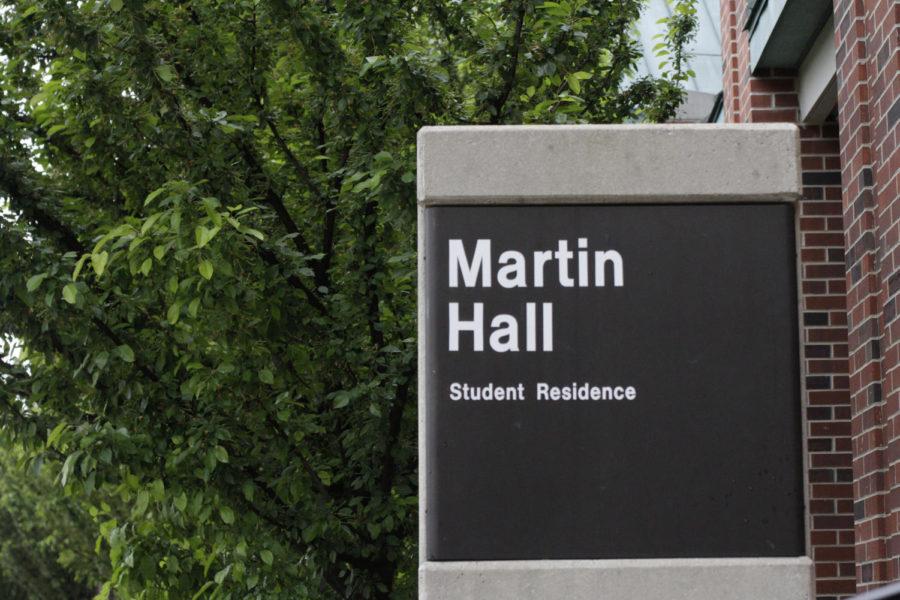Racist whiteboard drawing shakes Martin Hall
October 31, 2021
Zachary Komanapalli was grabbing lunch with friends one Friday in early October when he heard about the racist whiteboard drawing in Martin Hall.
“Some of my peers in the hall had talked about how one of the drawings was defaced to depict a KKK rally crucifying a black man and that being symbolic of like a colored-in Among Us character to be completely black with the words #whitesupremacy written on the board,” Komanapalli said.
Komanapalli, a sophomore in aerospace engineering and resident of Martin Hall, did not see the defaced whiteboard in the South den of Starbuck Hall that day, but he did not take the incident lightly. Within minutes of hearing about the incident, he was texting his floor resident advisers to inform them of the situation. Komanapalli said the floor RA’s immediately contacted authorities to figure out who had drawn the picture.
Joseph Ballard II, the director of diversity, equity and inclusion for campus life, said the ISU Police Department were contacted and continued to stay involved in this manner throughout every step the residence department took.
According to Ballard, after meeting with the party affected and reporting the incident, the ISU Police were the first ones contacted. From there, Ballard said an incident report was made and leadership members from the department of residence were notified.
Police Chief Michael Newton gave a statement regarding the incident.
“We did receive a report from a third party on this,” Newton said. “The whiteboard had been erased before police were contacted. It was documented and determined there was not a criminal case. The team from the Department of Residence followed protocol by alerting us to review and they are working with those impacted.”
According to Ballard, that was the next step — continuing to support and care for individuals with the help of the department’s partners and the ISU Police.
According to the Department of Residences’ statement regarding the incident, while the department can try to foster a supportive and safe environment for all students, they are not able to control the actions of each individual. The only thing they are able to control is how they support those affected by the situation.
“Unfortunately, we cannot prevent individuals from inserting reprehensible imagery into the public square, but whenever such acts occur, we will signal clearly where we stand and remain fully committed to working with like-minded community members to direct their talents, skills and abilities toward the creation of live-in learning communities that afford each student a place of safety and support as they pursue their personal and professional goals,” the department said.
The statement continued to detail the steps that were taken to address the situation.
“In this case, a student encountered an offensive image on a den whiteboard and erased it,” the statement said. “In addition, they appropriately alerted our staff so that we could launch our protocol, which included notification of the police, outreach statements and resources provided to the staff and members of the impacted community. These actions were followed by a house meeting attended by student leaders, residents and staff to discuss the incident and to clearly define what characteristics would define their community going forward.”
This house meeting was where Komanapalli decided to share his thoughts on the incident. In a speech written before the meeting, Komanapalli addressed the incident and its effects on him and his community.
“In dealing with this conflict, I have found a number of initial reactions likening the words to, at worst ‘a joke,’ and the ever so milder ‘joke in bad taste,’” Komanapalli said. “But to my friends here from historically marginalized communities, the static indifference of many to such attempts at ‘humor’ rings hollow with the echoes of white silence in the wake of atrocities of the past.”
According to Komanapalli, having individuals take the racist incident in Martin Hall seriously has been very challenging.
“So, among my whiter colleagues, my colleagues that are normally not subjected to racial prejudice, they chalked it up to, ‘Don’t you think that’s a bit of an overreaction,’” Komanapalli said.
Komanapalli continued to say that when incidents like this are considered nothing but a joke, that makes discriminated communities feel invalidated. He said that while society as a whole has come a long way in the fight for racial and cultural equality, there is still a long way to go.
“I mean we do a number of different training coming into university or even just in some of our classes talking about how bigotry is still a issue and all that, and I think almost everyone is cognizant of that, but when it comes down to the wire and these small events happen, I think there’s a bit of seizing up that we have and a bit of innate difference to saying, ‘That’s humor. That’s a joke. That’s not actually what we’re seeing here,’” Komanapalli said. “Whether that’s denial, or people just being uncomfortable with it, or maybe people being uncomfortable with the fact that they can’t see it, I’m not sure. But, it does speak to a larger cultural issue on the campus and probably our society at large.”
According to Komanapalli, the results of the police investigation showed that while no one living in Martin Hall was responsible for the defacing of the whiteboard in Starbuck house, it is most likely the act of a resident’s guests.
Komanapalli said that while he feels some assurance that the responsible party most likely does not live in Martin Hall, the incident still remains in the back of his mind everyday.
“It definitely has forced me to think about how that stuff’s treated here on campus,” Komanapalli said. “It’s brought that question to mind, a question that wasn’t previously there.”
He also said that this situation has made him wonder how many other incidents like this have happened but have been brushed off as humor. According to him, this brushing off could be the result of peer pressure many students face on campus to not take incidents like this seriously, or it could be higher administration believing that the situation was not worth their time.
“The student government and the university itself can do a lot, and it’s always appreciated when they help make it easier and they can definitely do a lot to help make this cultural shift easier,” Komanapalli said. “They can provide the resources, the training, the manuals, all that stuff to make this easier, they could totally do that and I think they should. But, ultimately, the responsibility for changing the culture is on the individual.”
While Komanapalli believes that the only true way to attempt to fix the problem of racism and bigotry on campus is by individuals changing the way they think and treat others and situations, he still urges Student Government and Iowa State to think deeply about how they can improve campus culture.
“Yes, it is their [the individual’s] responsibility, but you [Student Government] should definitely do something,” Komanapalli said. “In fact, I would use stronger language than that. They must do something to change that culture.”







